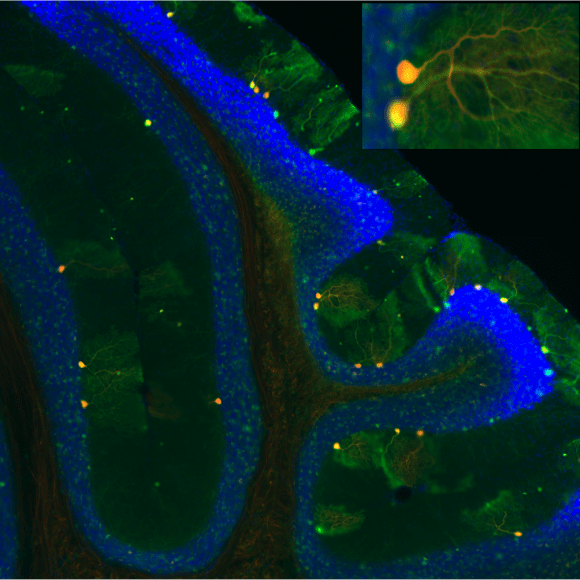
The NeuroSeq project (2012-2015) was an interdisciplinary effort directed at characterizing the transcriptional state of defined neural cell types in both fly and mouse, using next-generation sequencing technologies and new technologies for purifying individual cell types and individual neurons.
The goals of the NeuroSeq Project Team are to provide information about the transcriptional state of specific neuronal cell types and to identify markers of cellular identity and function.
Neurons are the fundamental building blocks of the nervous system, serving as the essential sensors, integrators and actuators of neural function. Hundreds of different neuronal cell types produce the proteins and RNAs they need to fulfill their roles in this intricate system by activating unique sets of genes. Within each cell the genome is epigenetically modified and transcriptionally programmed to produce the precise anatomical connectivity and exquisitely fine-tuned physiology needed for neural circuit function.
To understand this complex process, it is critical to map not only phenotypes like connectivity and neuronal physiology, but also the gene networks that enable them. A first step toward this goal is to determine the set of genes that is expressed in each cell type. The tools to acquire this data are at hand for genetic organisms like Drosophila (fruit fly) and Mus musculus (mouse), and the NeuroSeq project team aims to exploit them.
In its first two years, NeuroSeq established pipelines for transcriptional profiling of mouse and fly cell types using RNAseq technology. Our methods, use genetically tagged cell populations purified by manual sorting, or tagged nuclei populations purified biochemically by the INTACT method. Nearly 200 mouse and 49 fly cell types (or conditions) have been profiled.
With the advent of next-generation sequencing and the ability to prepare cell-type specific sequencing libraries from biochemically or manually sorted samples, we can now ask more sophisticated questions about the transcriptomes (the sets of RNA molecules produced from a cell's active genes) of specific types of neuronal cell. Some of the questions that have motivated the NeuroSeq project team and that will guide our efforts over the coming years are listed below. Even partial answers to these questions may provide critical insights into the biology of particular neuronal cell types and the functional organization of the nervous system in flies and mammals.
Specific genes:
What transcription factors regulate transcription in adult neurons? What ion channels and receptors determine the cellular and synaptic properties of these neurons? What synaptogenic and cell adhesion molecules initiate and maintain synaptic connectivity? What cytoskeletal proteins contribute to dendritic and axonal morphologies?
Global features of transcription:
How widespread is alternative exon usage? Does this differ across specific cell types or across species? How are nuclear and somatic RNA profiles related? Do these relationships vary across cell types? Which noncoding transcripts are cell type- specific? Do cell type-specific noncoding RNA represent enhancers, long noncoding RNAs, microRNAs or other transcripts?
Features of cell types:
Can we identify transcriptional modules of co-regulated genes that confer specific physiological properties, like transmitter phenotype, or that reflect common embryonic origin? Can we infer patterns of connectivity based on which cells express specific receptors and their ligands? Can neuromodulation be better understood by identifying the distribution of metabotropic receptors across cell types? How do major cell types (cerebellar granule cells, Kenyon cells, CA1 pyramidal neurons) which can be subdivided genetically or anatomically differ in gene expression? Once more “atomic” cell types are obtained, can single-cell transcriptomics be used to assess which features of gene expression are stereotyped and which vary across individual neurons?
To address these questions we are working to:
- develop surgical and genetic approaches to label specific populations of neurons in fly and mouse brains for a broad range of cell types and neural circuits
- isolate pure samples of healthy neurons or intact nuclei while minimizing stress-induced changes in the transcriptional profile
- investigate methods to isolate and analyze the gene expression of single cells
- generate cDNA libraries representative of the sample expression profile for high throughput next-generation sequencing
- quantify the expression levels of all genes in the mouse and fly transcriptome
- identify specific markers of cellular identity and function
- enable genetic access for labeling additional neuronal populations
- understand the regulation of gene networks that confer cellular morphology, physiology, function, and identity
